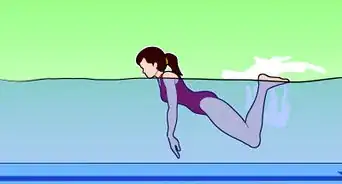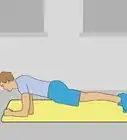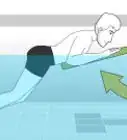This article was co-authored by Brad Hurvitz and by wikiHow staff writer, Dan Hickey. Brad Hurvitz is a Certified Swimming Instructor for My Baby Swims, an adolescent swimming school based in La Jolla, California. Brad is trained as an Infant Swimming Resource (ISR) instructor with ISR's Self-Rescue® program. He specializes in training children aged six months to six years of age survival skills like floating on their back to breathe and swimming back to the wall, while also educating parents on how to better keep their kids safe. He has a Master of Business Administration from Oregon State University.
There are 12 references cited in this article, which can be found at the bottom of the page.
This article has been viewed 129,124 times.
The flutter kick is a small but mighty and versatile move in swimming, whether you’re competitive or just splashing around for fun. Perfecting the flutter kick just takes a little practice, and once you get the feel for it, it’s all smooth sailing. In this article, we’ll walk you through everything you need to know to practice and master the flutter kick, including familiar strokes that use it and the most common mistakes to watch out for. Go ahead and jump right in whenever you’re ready (the water feels fine, we promise!).
Things You Should Know
- Make small kicks with your hip muscles and keep your legs long and straight. Relax your knees and ankles and point your toes behind you.
- Hold onto a pool wall or use a kick board to isolate the kick and practice without having to coordinate with your arms.
- Use the flutter kick in popular strokes like the freestyle, backstroke, or dog paddle.
Steps
Isolating the Kick
-
1Place your hands against a pool wall to hold yourself steady. Push your feet off the ground and extend your legs behind you so you’re nearly floating (your feet will want to keep sinking down). Hold your arms out straight so you’re as horizontal as possible in the water.[1]
- Have children or people who don't want to be underwater hold their head above water (or put their arms on top of the wall so their head and arms are dry).
- As you get more comfortable with this position, practice lowering your face into the water. Your body will float easier and stay aligned when your head is down.
- Try a snorkeling mask in the beginning so you can keep your head down. Later, ditch the mask and lift your head above water when you need to breathe.
-
2Use your hip muscles to push one leg down in the water. Begin your kick cycle with your dominant leg. Keep your entire leg fairly straight and relaxed through the knee and ankle joints without bending your knee very much (this helps you stay streamlined).[2]
- Keep your toes pointed and turned slightly inward.
- Feel the power of the kick move from your hip, through your knee, and finish in your foot. Your foot moving down through the water creates propulsion.
Advertisement -
3Repeat with the other leg while you lift your first leg back up. In the beginning, let your first leg float back up on its own—as you master the kick, keep your hip muscles engaged to raise your leg and balance your kick strokes.[3] Remember to power your kick from the hips and push the water backward with pointed toes.[4]
- Keep your kicks fairly small. It’s OK if your heels break the surface of the water, but keep the majority of your kick in line with your body.
- To develop your upbeat (raising your leg during a kick cycle), position yourself vertically in the water and kick back and forth rather than up and down.
-
4Continue alternating legs to flutter kick. Maintain alternating beats—as one leg goes down, the other comes up. Increase the speed as the motions become more comfortable. When you flutter kick quickly, the force will drive your legs and hips upwards so they’re horizontally aligned with your body.[5]
- If your legs keep sinking, push your chest slightly further down in the water to balance your body alignment.
- If your legs are rising too much, keep your chest slightly higher in the water or try kicking with lower speed and power.
- Hold the wall until you can maintain a balanced, horizontal body position while kicking and barely touching the wall. Then it’s time to get moving!
Adding Movement
-
1Hold on to a kick board to support yourself while kicking. Instead of a wall, grab a kick board by the short edge and hold it at arm’s length in front of you. Push off of the pool floor to elongate your body horizontally, then start flutter kicking like before. If you’re using proper form, you’ll start moving forward.[6]
- Try to keep your head down (and come up to breathe) or use a snorkeling mask to keep your full body aligned.
- Notice how the kick propels you forward and holds your legs up.
- Avoid using a kickboard for someone younger than 6 years old since it may not teach proper swimming technique.[7]
-
2Push off from a pool wall to practice gliding and body alignment. At the surface or under the water, place your feet against a wall and straighten your legs to push off. Extend your arms in front of you (one hand over the other, like a torpedo), elongate your body into a horizontal line, and point your toes.[8]
- Glide through the water and begin flutter kicking as soon as you feel yourself losing momentum.
- Kick fast enough to keep your body horizontal. Most of your speed will come from adding arms (kicking powers about 15% of your speed).
- For practice, try gliding a few times without adding the kick to get used to the feeling of your body cutting through the water.
-
3Practice timing your kicks with arm strokes. Push downward with the leg opposite from the arm that’s starting your stroke cycle (for example, extend your right arm forward, over your head, and bring it down through the water while your left leg begins kicking), and repeat on the opposite side.[9]
- There’s no rule on how many kicks per stroke you need, but the most common ratios are the 2-, 4-, and 6-beat kicks:[10]
- 2-beat kick: Kick each leg once per stroke cycle (a cycle means both arms have completed a stroke).
- 4-beat kick: Kick each leg twice per cycle (in other words, each leg kicks once for each arm stroke).
- 6-beat kick: Kick each leg 3 times per cycle. Kick right-left-right while your left arm strokes, then left-right-left while your right arm strokes.
- There’s no rule on how many kicks per stroke you need, but the most common ratios are the 2-, 4-, and 6-beat kicks:[10]
Strokes with Flutter Kicks
-
1Freestyle stroke To swim freestyle (front crawl), flutter kick and make sweeping windmill motions with your arms. Reach each arm forward and bring it into the water fingertips-first, just wider than your shoulders. Bend at the elbow and scoop the water behind you to propel forward.[11]
- Picture your forearm and hand like a giant paddle. This is called an early vertical forearm (EVF).
- Keep your elbows high as your hand exits the water. As a rule of thumb, keep your elbows higher than your hands both above and below the water.
- Notice how the flutter kick stabilizes your body position and supports the movement of your arms.
-
2Backstroke To do a backstroke, float on your back and elongate your body into a straight line. Flutter kick like normal, except now you’re pushing up on the water instead of down. Use your shoulders to lift each arm out of the water thumb-first and rotate them backward, similar to a freestyle stroke.[12]
- Keep your arm straight and enter the water pinky-first with your palm facing outward. Rotate your palm down and use it to scoop or push the water back.
- As your arm comes up, rotate your palm inward before it breaks the surface of the water for the next stroke.
- Keep your form the same as usual—drive the kick from your hips, keep your knees mostly straight, and point your toes behind you.
-
3Dog paddle Use the dog paddle to stay afloat or swim short distances. Keep your head above water and float from your chest. Alternately move each hand forward and downward, then backward and upward in circular motions under the water. Flutter kick as normal.[13]
- The dog paddle isn’t an official swim stroke, but is fairly intuitive and easy to accomplish (and it’s named after how your favorite 4-legged companions swim).
- Move your limbs slowly and let your mouth go under water to save energy. Push and kick faster to raise your head and breathe.
Common Mistakes
-
1Kicking too big Keep your legs and kicks in line with your body as much as possible, aiming to keep the amplitude of your kick at about 0.5 m (1.6 ft) (this means your feet shouldn’t move more than this distance above or below your hips). When you start making huge, wide kicks, you end up creating drag which slows you down (and takes a lot more energy).[14]
- Remember, big kicks don't equal fast swimming. To increase your speed, keep your kicks fast and small.
-
2Bending too much at the knees Let your knees relax so they bend slightly with the pressure of the water rather than bending them on purpose to propel yourself. These “bicycle” kicks feel natural, but they ruin your streamlined body position and throw you off balance.[15]
- Remember to drive your kicks from the hips and to keep your legs fairly straight. This helps with propulsion and counterbalancing your arm strokes.
- Kicking at the knees will make your legs sink, causing you to slow down and lose your forward-moving momentum.
-
3Kicking down instead of backward Imagine pushing water backward and away from you with your feet rather than sending it downward. To do this, keep your ankles loose and flexible and your toes pointed—if your ankles are stiff or locked, you’ll have to bend your knee nearly 90 degrees to get any push.[16]
- Keeping your ankles loose and your toes pointed helps balance your upbeat (the lifting of your leg during a kick) with the downbeat (pushing your leg down).
References
- ↑ https://www.enjoy-swimming.com/flutter-kick-1.html
- ↑ https://wallenswim.com/common-errors-flutter-kicks-whip-kicks/
- ↑ https://www.yourswimlog.com/freestyle-kick/
- ↑ https://www.enjoy-swimming.com/flutter-kick-1.html
- ↑ https://www.trainingpeaks.com/blog/four-ways-to-improve-your-freestyle-kick/
- ↑ https://www.enjoy-swimming.com/flutter-kick-1.html
- ↑ Brad Hurvitz. Certified Survival Swimming Instructor. Expert Interview. 13 February 2020.
- ↑ https://www.enjoy-swimming.com/flutter-kick-1.html
- ↑ https://www.trainingpeaks.com/blog/four-ways-to-improve-your-freestyle-kick/
- ↑ https://www.usms.org/fitness-and-training/articles-and-videos/articles/kick-timing-101?Oldid=3061
- ↑ https://blog.myswimpro.com/2021/06/04/how-to-swim-freestyle-for-beginners-5-step-guide/
- ↑ https://www.swimming.org/masters/improving-your-backstroke-technique/
- ↑ https://www.enjoy-swimming.com/dog-paddle.html
- ↑ https://blog.myswimpro.com/2021/05/18/5-biggest-kicking-mistakes-swimmers-make/
- ↑ https://www.trainingpeaks.com/blog/four-ways-to-improve-your-freestyle-kick/
- ↑ https://www.yourswimlog.com/freestyle-kick/
- ↑ https://www.enjoy-swimming.com/flutter-kick-1.html
- ↑ https://youtu.be/ANVdMDaYRts?t=29
- Videos provided by SwimTechnique TV
Expert Q&A
Did you know you can get expert answers for this article?
Unlock expert answers by supporting wikiHow
-
QuestionHow do I make my flutter kicks stronger?
 Brad HurvitzBrad Hurvitz is a Certified Swimming Instructor for My Baby Swims, an adolescent swimming school based in La Jolla, California. Brad is trained as an Infant Swimming Resource (ISR) instructor with ISR's Self-Rescue® program. He specializes in training children aged six months to six years of age survival skills like floating on their back to breathe and swimming back to the wall, while also educating parents on how to better keep their kids safe. He has a Master of Business Administration from Oregon State University.
Brad HurvitzBrad Hurvitz is a Certified Swimming Instructor for My Baby Swims, an adolescent swimming school based in La Jolla, California. Brad is trained as an Infant Swimming Resource (ISR) instructor with ISR's Self-Rescue® program. He specializes in training children aged six months to six years of age survival skills like floating on their back to breathe and swimming back to the wall, while also educating parents on how to better keep their kids safe. He has a Master of Business Administration from Oregon State University.
Certified Survival Swimming Instructor
-
QuestionHow do you get a stronger freestyle kick?
 Brad HurvitzBrad Hurvitz is a Certified Swimming Instructor for My Baby Swims, an adolescent swimming school based in La Jolla, California. Brad is trained as an Infant Swimming Resource (ISR) instructor with ISR's Self-Rescue® program. He specializes in training children aged six months to six years of age survival skills like floating on their back to breathe and swimming back to the wall, while also educating parents on how to better keep their kids safe. He has a Master of Business Administration from Oregon State University.
Brad HurvitzBrad Hurvitz is a Certified Swimming Instructor for My Baby Swims, an adolescent swimming school based in La Jolla, California. Brad is trained as an Infant Swimming Resource (ISR) instructor with ISR's Self-Rescue® program. He specializes in training children aged six months to six years of age survival skills like floating on their back to breathe and swimming back to the wall, while also educating parents on how to better keep their kids safe. He has a Master of Business Administration from Oregon State University.
Certified Survival Swimming Instructor
-
QuestionWhen I kick with backstroke, I feel like I'm going much slower than freestyle. Any tips?
 Community AnswerWhen kicking backstroke, focus on keeping your toes and hips up. People usually go slower on their back when they kick because they lean their heads too far forward, which causes the hips to fall. Think about keeping your head perfectly straight toward the sky/ceiling, and focus on bringing your toes up to the surface. Do not bend your knee to kick, use your whole leg.
Community AnswerWhen kicking backstroke, focus on keeping your toes and hips up. People usually go slower on their back when they kick because they lean their heads too far forward, which causes the hips to fall. Think about keeping your head perfectly straight toward the sky/ceiling, and focus on bringing your toes up to the surface. Do not bend your knee to kick, use your whole leg.
Warnings
- Practice flutter kicks (and do all your swimming) in a pool or designated swim area with a lifeguard on duty. For extra safety, learn new techniques from a swimming instructor.⧼thumbs_response⧽
About This Article
To flutter kick, start by pushing one of your legs down into the water with your toes pointed and turned slightly inward. Then, as your leg is floating back up in the water, repeat with your other leg. Continue alternating your legs and increasing your speed, making sure your feet aren't breaking the surface of the water. To practice flutter kicking, try holding onto a kickboard so it's easier to propel yourself forward. You can also push off from the pool wall before flutter kicking to give yourself some momentum. To learn how to combine other swim strokes with flutter kicks, scroll down!

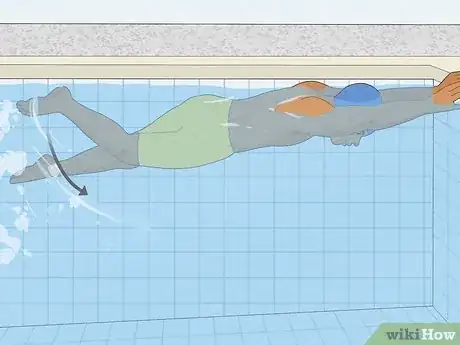


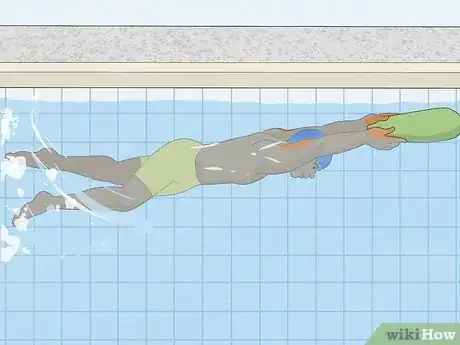


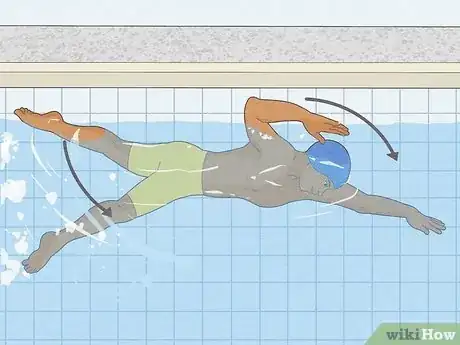


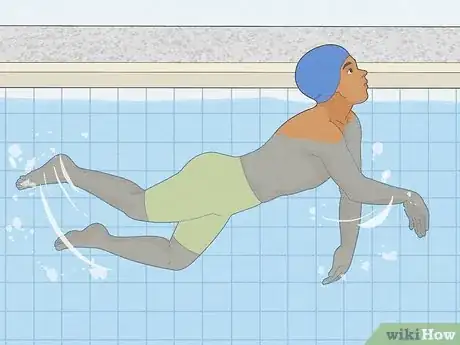
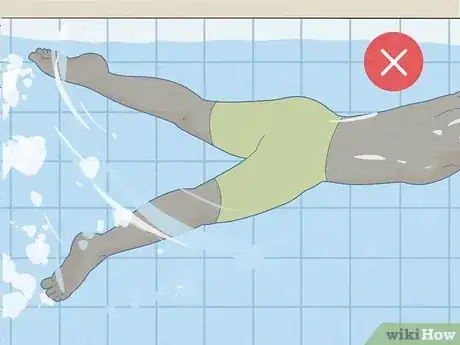

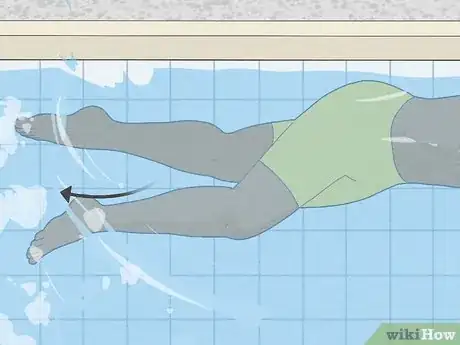


-Step-11.webp)

-Step-7-Version-2.webp)


